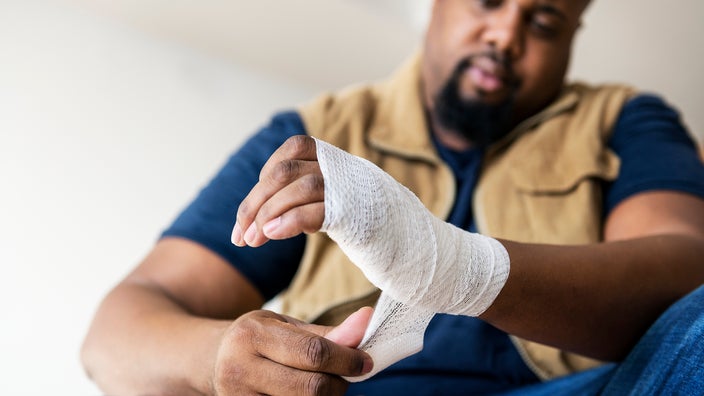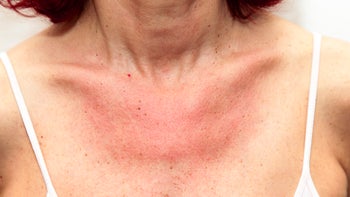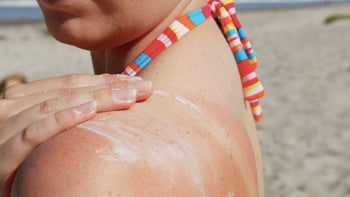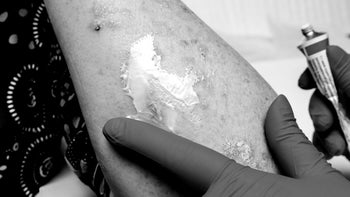
Is It Safe to Use Liquid Stitches (Dermabond) on Your Skin Cut? Here’s How to Tell
Key takeaways:
Liquid stitches are a specially formulated glue a healthcare provider can apply to cuts on your skin to help them heal.
For certain cuts, liquid stitches have some advantages over regular stitches. They’re quicker and more comfortable. And they decrease the risk of scars just as well as regular stitches.
It’s best to see a medical provider if you think you need liquid stitches. They can make sure they’re the right choice and help clean and close the cut in a way that minimizes infection and scarring.

Liquid stitches, or Dermabond, are like a medical-grade “super glue” for skin. In the right setting, Dermabond can be a great option to help some small wounds heal. But there are some important things to know about liquid stitches.
First, liquid stitches only work on certain cuts. And not all cuts need stitches or are suitable for at-home treatment. Second, liquid stitches are specially formulated to be used on the skin. So before you reach for super glue to treat a cut on your own, let’s take a closer look at how liquid stitches work.
How do liquid stitches work?
Dermabond comes in a thin pen with a spongy tip. Inside the pen, there’s a special liquid made from cyanoacetate and formaldehyde. When these chemicals come in contact with skin, they connect to form a small bridge across a cut or laceration. This creates a solid gel that seals and closes the cut.
Search and compare options
Healthcare providers sometimes use liquid stitches in place of traditional needle-and-thread stitches (sutures). They generally work well for smaller cuts that are clean. Liquid stitches are a little different than over-the-counter (OTC) products labeled as “liquid bandages.” Dermabond is a different substance, and it’s a bit stronger. Plus, healthcare providers are skilled at knowing how and when to use them.
When to use liquid stitches
Although Dermabond can be a great choice, it doesn’t work well for all cuts. For liquid stitches to work, a cut should be:
Small: The cuts should be less than 2.5 cm and shallow. Deep cuts often need something stronger to hold the skin edges together.
Clean: Risk for infection increases if the cut got dirty when it happened or you were cut with a dirty object. You shouldn’t use Dermabond in these cases because it can increase infection risk.
Dry: The cut shouldn’t bleed after you wash it out. Dermabond does not work on wet surfaces.
Straight: Cuts that have jagged edges usually need traditional stitches. It’s hard for the liquid stitches to bring the edges together smoothly.
Not gaping: The edges of the cut should come together easily. Gaping cuts often need something stronger to keep the edges close together.
When not to use liquid stitches
There are certain conditions where it’s best to avoid Dermabond. These include:
Dirty cuts: Infection risk increases if you close a dirty cut with Dermabond. This includes cuts that involve a dirty object or rusty metal and cuts that occurred in water or mud.
Bites or punctures: Animal bites or puncture wounds are considered “dirty” and can be a risk for infection.
Deep cuts: Deep cuts need suture to help hold the wound edges together. Dermabond is not strong enough to do this.
Mucosal surface: The skin is often moist inside the mouth and nose. Liquid stitches do not stick well in these wet conditions.
Lip margins: If a cut crosses the edge of where the lip meets the skin (known as the vermillion border), it needs to be lined up well. Regular stitches allow for more precision during wound repair.
Joints: Joints or areas with a lot of movement (like hands and feet) are not ideal places for Dermabond. In general, the glue is not strong enough to withstand all the bending and moving.
Advantages of liquid stitches
Liquid stitches can have many advantages over traditional sutures. These include:
No needles: With children or anyone who does not like needles, this can be a big plus!
Faster: Liquid stitches can be applied relatively quickly, and they dry in a few minutes.
No need for stitches removal: Regular stitches require a second visit so your provider can remove them. Dermabond only needs one provider visit. For most people, the glue peels off within 5 to 10 days.
Water resistant: Dermabond is not waterproof. But it provides some protection against the wound getting wet.
As strong as healed skin at 7 days: If the cut is small enough, the wound should be as strong as it was before the injury.
Equivalent results: Studies have shown that they work well when used on the right cuts. And they decrease the risk of scarring as much as traditional sutures.
Read more like this
Explore these related articles, suggested for readers like you.
Disadvantages of liquid stitches
There are a few drawbacks to using Dermabond:
Spotting infection: Dermabond can make it harder to see if an infection is developing. And because the wound edges are sealed shut, it can be harder for things to drain out.
Wound dehiscence: Sometimes, even with a small cut, the glue can’t hold the edges together, and the cut reopens. If this happens, the cut can’t be glued or stitched again. It has to heal on its own without help, which can take a lot longer.
Allergic reaction: There’s a small chance the skin can have a reaction to the liquid stitches and cause a rash on the skin. Usually this occurs in people who have liquid stitches more than once. Most studies show the risk to be relatively low. Reports range from less than 1% and up to 14%.
How do you use Dermabond?
Applying Dermabond is fairly straightforward, but a medical professional should do it. They can check your cut and make sure it’s safe and appropriate to use liquid stitches instead of normal stitches. They also have experience in how to clean the wound and apply the Dermabond to have the best results.
It’s a fairly quick and painless procedure. Here are the general steps:
Clean the cut. The injured area should be cleaned very well before applying Dermabond. This usually involves flushing the cut with water for several minutes, and then allowing it to fully dry.
Push the skin edges together. Your provider will align the edges of the cut and gently push them together.
Apply the Dermabond. Your provider applies the glue in quick strokes, three times. Sometimes this part can sting a bit, when the chemicals enter the cut.
Allow time to dry. Liquid stitches dry and reach their maximum strength in 2.5 minutes.
How do you care for liquid stitches?
After you receive Dermabond, there are not a lot of restrictions or care instructions. Follow these guidelines:
Leave it open: You don’t need to cover the cut. But if it will help prevent further injury (including picking), it’s OK to lightly cover the area with a bandage.
No swimming or baths: Try to minimize contact with water because it can cause the glue to peel off too soon. Water can also cause the wound to reopen.
No ointments: It may seem natural to apply antibacterial ointments to help prevent infection. But these topical medications can break down the liquid stitches too soon.
The bottom line
Liquid stitches can be a great alternative to regular stitches. Dermabond is safe, fast, and fairly painless. While there are liquid-stitch products available over the counter, it’s best to have a medical professional evaluate your cut. They can help you choose the best option for taking care of your cut and take steps to minimize infection risk. If liquid stitches are a good choice for you, your provider can apply the glue so you can have the best outcome.
Why trust our experts?


References
Beam, J. W. (2008). Tissue adhesives for simple traumatic lacerations. Journal of Athletic Training.
Bruns, T. B., et al. (2000). Using tissue adhesive for wound repair: A practical guide to Dermabond. American Family Physician.
Shupak, R. P., et al. (2021). Skin hypersensitivity following application of tissue adhesive (2-octyl cyanoacrylate). Baylor University Medical Center Proceedings.





























